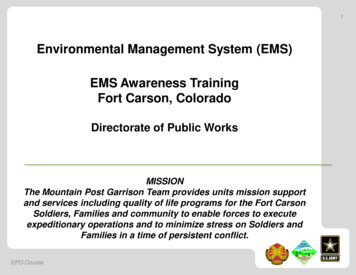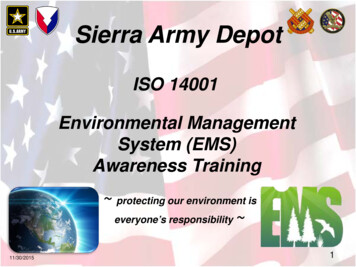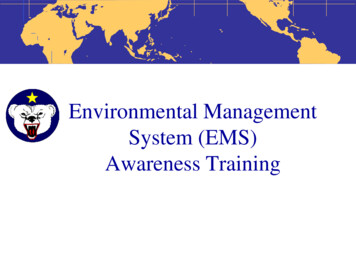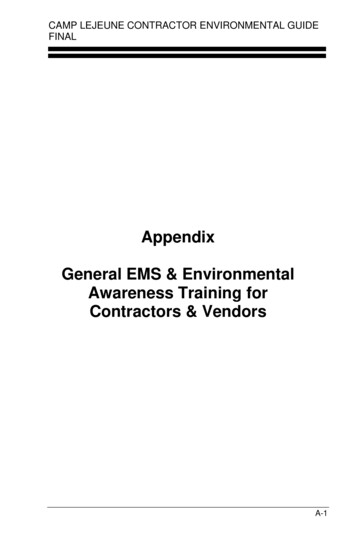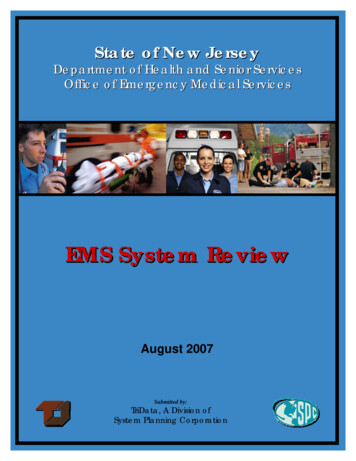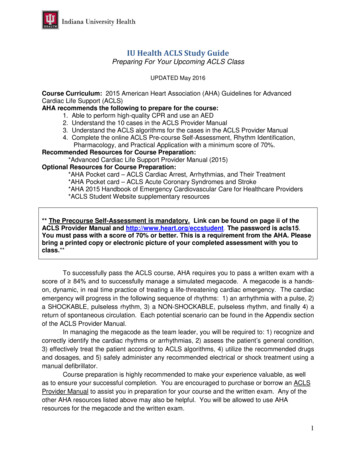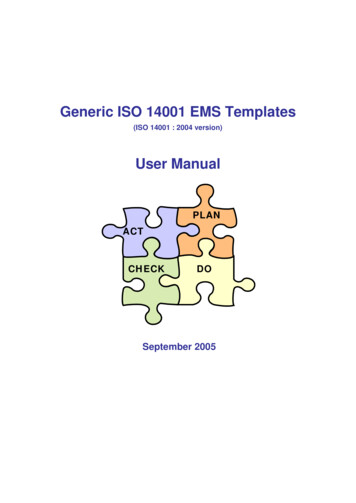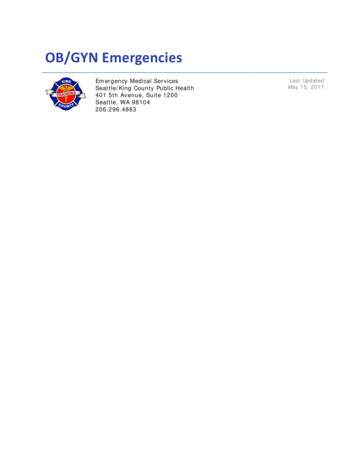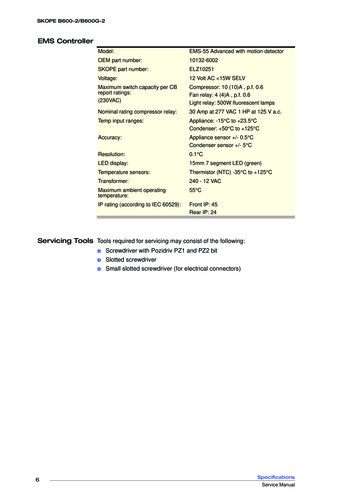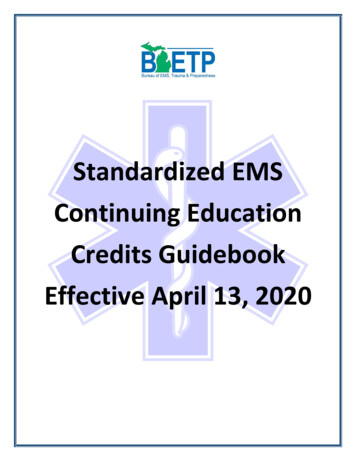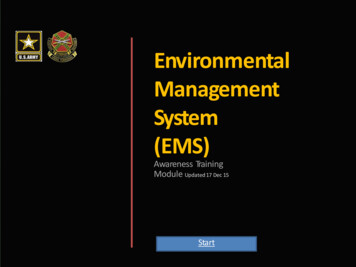
Transcription
EnvironmentalManagementSystem(EMS)Awareness TrainingModule Updated 17 Dec 15Start
Comply with all applicableenvironmental regulations, polices anddirectives Assess our activities/services todetermine potential effects onthe environment. Implement Objectives andTargets through EMS Implement Pollution Prevention(P2) strategies Continually Improve our EMS12/17/20Previous / Next2
EMS stands for Environmental Management System which is a managementapproach based on continuous improvement aimed at long term missionsustainability to prioritize and manage the various environmental concerns at aninstallation.EMS serves as a framework to systematically identify and reduce anorganization’s impact on the environment while maintaining mission focus.An EMS Is NOT a computer software program Is about management practices and planning Involves everyone at all levels of the installation including Senior Leadership! Remember EMS is a management process, not an environmental program.12/17/2015Previous / Next3
An EMS is a framework that allows an organization to understand andconsistently control the effects of its operations on the environment through asystem or cycle of Plan, Do, Check and Act, which promotes continuousimprovement and maintains mission focus.CONTINUOUS NG &CORRECTIVE N& OPERATION(DO)Previous / Next4
During the Planning Phase (PLAN) the environmental aspects and impacts of theinstallation’s activities are identified and prioritized in order to establishenvironmental goals in support of the mission.The Implementing Phase (DO) involves putting into place operational controls,documented procedures, specific roles and responsibilities, and providingtraining to manage those activities with high priority or significant aspects.During the Checking Phase (CHECK) the management system is monitored andassessed based on established performance measures. Corrective actions areproposed for non-conformances.Senior Leadership reviews the performance status of the EMS during theReview Phase (ACT) and takes the necessary corrective actions to improve theEMS.12/17/2015Previous / Next5
Now that you have a basic understanding of the concepts of an EMS, Your roleas Environmental Officer, military staff, civilian, local national, orcontractor, your responsibilities and actions are related to a successful EMS.Let us look further at the following terms. Activities, Products and Services Environmental Aspects Environmental Impacts12/17/2015Previous / Next6
Activities, products, and services are best described by the work processperformed at an installation everyday.Examples includes: Changing oil in a vehicle, spot painting,repairing an engine Producing a report Providing heating and cooling,food and administrative services12/17/2015Previous / Next7
An environmental aspect is an element of the organization’s activities, products,and services that can interact with the environment. Think of aspects as the“cause” of environmental impacts.Examples include: Waste generation (e.g., used oil,solvent, waste paint) Fuel spills Paper consumption Energy consumption12/17/2015Previous / Next8
The environmental impact can be described as any potential change to theenvironmental aspect and the associated activity, product, or service.Environmental impacts can be thought of as the “effect” in a cause and effectRelationship, for example:Soil or watercontamination Waste generation (e.g., used oil,solvent, waste paint)Air Pollution Fuel spills Paper consumptionReduction oflandfill space Energy consumption, recycling12/17/2015Previous / Next9
Based on risk analysis of all environmental aspects, USAG Yongsan identified thefive most significant. Once it becomes a significant aspect, the EnvironmentalManagement Program (EMP) being developed and operational controls will beimplemented to reduce the risks.USAG Yongsan SignificantEnvironmental AspectsBulk Fuel/Chemical SpillStorm Water DischargeHazardous Waste GenerationSolid Waste GenerationEnergy Consumption12/17/2015Previous / Next10
Activity:Receiving (Filling), Storage, and DistributionEnvironmental Aspect:UncontrolledAccidental Releases (e.g., spill)Environmental Impact:Contaminated SurfaceWaters (e.g., Rivers, Streams, and Ocean); and Soil& GroundwaterWhat do we do for ContinuousImprovement? Reduce Accidental Spills through training Control Spills through follow SOP12/17/2015Previous / Next11
Activity: Industrial Activities,Car Wash, and Operation andMaintenance of Oil-Water SeparatorsEnvironmental Aspect: ContaminantsDischarged via Storm water SystemEnvironmental Impact:Contaminated SurfaceWaters (e.g., Rivers, Streams, and Ocean); and Soil& GroundwaterWhat do we do for ContinuousImprovement?Minimize contaminants in wastewater going intothe storm water system; and wastewatergeneration.Previous / Next12/17/201512
Activity: Office and AdministrativeWork; Housing/BilletingOperations; and Solid Waste ManagementEnvironmental Aspect: Solid WasteGenerationEnvironmental Impact: Depletion of LandfillSpace; and Soil & Groundwater ContaminationWhat do we do for ContinuousImprovement?Reduce Solid Waste Generation; andRecycle and Reuse12/5/2015Previous / Next13
Activity: Operation and Maintenance of Housing/Billeting,Industrial Shops, Golf Course, and LandscapeEnvironmentalAspect: Hazardous WasteGenerationEnvironmental Impact: Soil & GroundwaterContamination; Degradation of Air QualityWhat do we do for ContinuousImprovement?Minimize Hazardous Waste Generation;Recycle/Reuse; and UseAlternative Chemicals12/5/2015Previous / Next14
Activity: Office and AdministrativeWork; and Operation andMaintenance of Facility; Heating & CoolingEnvironmental Aspect: Consumption ofElectrical Power; and Heating FuelEnvironmental Impact: Degradation of AirQuality ; Depletion of Fossil Fuel Resources;and Global WarmingWhat do we do for ContinuousImprovement?Comply with Energy ConservationRequirements; Use Sub-metering12/17/2015Previous / Next15
You have successfully navigated the key concepts of environmental aspects andimpacts and how they are related to your work. Your role as EnvironmentalOfficer and Military Staff plays an important to sustain ourenvironmental stewardship and our mission. You are required to: Compliance with all Environmental Policies Understand Significant Aspects Update your SOPs, Pollution Prevention andEmergency Response Plans12/17/2015Previous / Next16
EMS Management RepresentativePending appointmentChief of Environmental DivisionMr. Scott J. Weber, 724-6151, Scott.j.weber6.civ@mail.milEMS CoordinatorMr. David Sun, 724-6150, chung.y.sun.civ@mail.mil12/17/2015Previous / Next17
Ready for the test?The next screen is the test for this course.There are 10 questions on the test and you must select correct answers to pass.When you are ready to take the test, clickTEST hereIf you don’t want take test now, press “Esc”.10/5/201518
Wrong !TAKE AGAIN
Environmental Management System (EMS) program is;A. Is a computer system and software package.B. Is about management practices and planning.C. Is about environmental stewardship of an installation.D. Both b and c1/10
A successful Army Environmental Management System (EMS) will:A. Reduce mission impact on the environment.B. Strive to find better ways to distract inspectors fromfinding areas of non-compliance.C. Maintain a high level of regulatory compliance.D. Both a and c.2/10
Many federal agencies have active and effective pollution preventionprograms and waste management activities already underway. Theseprograms cannot be incorporated into an EMS:A. TrueB. False3/10
During which phase of an EMS does senior leadership take therequired actions to improve the established EMS Cycle?A. PlanB. DoC. CheckD. Act4/10
A successful EMS is the responsibility of:A. YouB. Top leadershipC. Supervisors and project managersD. All the above5/10
Which of the following is not a USAG Yongsan Significant EnvironmentalAspect?A. Spills related to Bulk Fuel ManagementB. Hazardous Waste GenerationC. Air Emissions managementD. Energy Consumption6/10
Which of the following is a part of the USAG Yongsan EnvironmentalPolicy?A. Comply with environmental laws and regulationsB. Identify and Implement Pollution Prevention strategiesC. Seek opportunities to Continuous ImprovementD. All of the above.7/10
To reduce mission impacts, the Army focuses on activities that happenon site and in the field.A. TrueB. False8/10
Only senior leadership and the environmental office need to understandwhat an EMS is and their EMS responsibilities.A. TrueB. False9/10
What can you expect to see from your senior leadership regarding EMS?A. Determine how your site impacts the environment.B. Set achievable objectives to address significantenvironmental aspects.C. Designate unit Environmental Officer and responsibilities.D. All of the above.10/10
Click the button below for your certificate andsend the printed certificate to USAG Yongsan EMSCoordinatorMr. David SunMr. David Sun, 724-6150, chung.y.sun.civ@mail.milCertificate
Certificate of trainingAwarded ToName:For Successful Completion of theEnvironmental Management System Awareness TrainingAs required by USAG Yongsan EMSE-mail:Date:
(EMS) Awareness Training Module Updated17 Dec 15 Start Comply with all applicable environmental regulations, polices and directives Assess our activities/services to determine potential effects on the environment. Implement Objectives and Targets through EMS Implement PollutionPrevention
